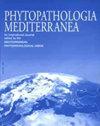Virulence and diversity of Puccinia striiformis in South Russia
IF 1.9
3区 农林科学
Q2 AGRONOMY
引用次数: 4
Abstract
Puccinia striiformis causes wheat yield losses in all countries where wheat is cultivated. Virulence and diversity of the P. striiformis were assessed in 2013–2018 in South Russia, and this showed that the North Caucasian population of the pathogen was diverse. One hundred and eighty two virulence phenotypes were identified in 186 P. striiformis isolates. Among isolates collected in 2014, 2015, and 2018, all phenotypes were unique. In the 2013 and 2017 populations, phenotypes with few (one to eight) virulence alleles prevailed. In the 2014, 2015, and 2018 populations, most of the phenotypes contained greater numbers (nine to 19) of virulence alleles. Over the 5 years of research, the pathogen population lacked isolates virulent to the host Yr resistance genes 3, 5, 26, and Sp. Single (from 1 to 5%) occurrences of isolates virulent to host lines with Yr genes 3a, 17, 24, 3b + 4a + H46, and 3c + Min were identified. Differences in frequencies of virulence alleles between years in the P. striiformis populations (Ney indices, N) were generally non-significant (N = 0.11 to 0.23), with the exception of the populations in 2013 and 2017 (N = 0.37). The minimum N values was found for the populations of 2015 and 2018 (N = 0.10). Over the five years of this study, the dynamics of the virulence of the population and jumps in the frequency of isolates with respect to many Yr genes were identified. This feature of the P. striiformis populations in South Russia, combined with high phenotypic diversity, indicates the ability for rapid race formation and morphogenesis in response to changes in biotic and abiotic factors.俄罗斯南部striiformis的毒力和多样性
纹状锈菌在所有种植小麦的国家造成小麦产量损失。2013-2018年对俄罗斯南部地区条纹状假单胞菌的毒力和多样性进行了评估,结果表明,北高加索地区的病原菌种群具有多样性。186株条纹状假单胞菌分离株共鉴定出182种毒力表型。在2014年、2015年和2018年收集的分离株中,所有表型都是独特的。在2013年和2017年的种群中,具有少量(1至8个)毒力等位基因的表型占主导地位。在2014年、2015年和2018年的种群中,大多数表型含有更多的毒力等位基因(9到19个)。在5年的研究中,病原菌群体中缺乏对宿主Yr抗性基因3、5、26和Sp有毒力的分离株。对携带Yr基因3a、17、24、3b + 4a + H46和3c + Min的寄主菌株有毒的分离株单一(1% ~ 5%)出现。除2013年和2017年种群间毒力等位基因频率差异(N = 0.37)外,各年种群间毒力等位基因频率差异(N = 0.11 ~ 0.23)普遍不显著(N = 0.11 ~ 0.23)。2015年和2018年种群的N值最小(N = 0.10)。在五年的研究中,确定了种群的毒力动态以及与许多Yr基因相关的分离株频率的跳跃。这一特征与高表型多样性相结合,表明在生物和非生物因素的变化下,该种群具有快速形成和形态发生的能力。
本文章由计算机程序翻译,如有差异,请以英文原文为准。
求助全文
约1分钟内获得全文
求助全文
来源期刊

Phytopathologia Mediterranea
生物-植物科学
CiteScore
4.40
自引率
8.30%
发文量
28
审稿时长
6-12 weeks
期刊介绍:
Phytopathologia Mediterranea is an international journal edited by the Mediterranean Phytopathological Union. The journal’s mission is the promotion of plant health for Mediterranean crops, climate and regions, safe food production, and the transfer of new knowledge on plant diseases and their sustainable management.
The journal deals with all areas of plant pathology, including etiology, epidemiology, disease control, biochemical and physiological aspects, and utilization of molecular technologies. All types of plant pathogens are covered, including fungi, oomycetes, nematodes, protozoa, bacteria, phytoplasmas, viruses, and viroids. The journal also gives a special attention to research on mycotoxins, biological and integrated management of plant diseases, and the use of natural substances in disease and weed control. The journal focuses on pathology of Mediterranean crops grown throughout the world.
The Editorial Board of Phytopathologia Mediterranea has recently been reorganised, under two Editors-in-Chief and with an increased number of editors.
 求助内容:
求助内容: 应助结果提醒方式:
应助结果提醒方式:


